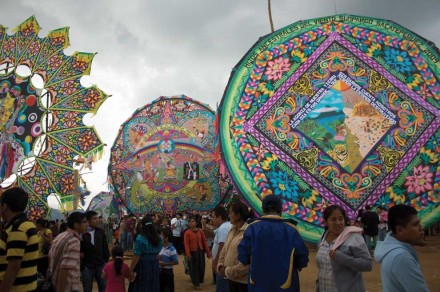Day of the Dead brings a Guatemalan spectacle
written by Alan García
The month of November begins with one of Guatemala’s most colorful traditions, El Día de Los Muertos (Day of the Dead), celebrated in large and small scale throughout the country in connection with the Catholic holidays of All Saints’ Day on Nov. 1 and All Souls’ Day on Nov. 2. In one Highlands community, a unique horse race adds a festive element to the holiday.
For over 100 years, one of the biggest celebrations has taken place on Nov. 1 in the predominantly Kaqchikel town of Santiago Sacatepéquez, 25 kilometers from La Antigua Guatemala, where giant circular kites, up to 15 meters (50 feet) in diameter, along with hundreds of smaller ones, take flight.
With intricate designs and color, the kites symbolize communication between the living and their deceased ancestors and illustrate the devotion of Guatemalan families to traditions and customs.
Teams of kite makers started working weeks ago, gathering bamboo and other raw materials that become the round frame, to be finished off with delicate tissue paper and long tails, which are said to scare away evil spirits. Prizes will be awarded for design, themes and much more.
In contrast to the grand display at Santiago Sacatepéquez, modest observances take place across the country, as families gather in local cemeteries to honor their departed loved ones. Relatives bring flowers, beads, candles, ornaments and other decorations in a day of reflection and togetherness.
As their kites flutter aloft, the families also share the traditional meal fiambre, a cold dish that is served only on this occasion. Some recipes call for more than 50 ingredients, including a variety of meats, fish, cheese, eggs and an assortment of vegetables cured in vinegar.
A related tradition occurs in the Western Highlands community of Todos Santos Cuchumatán on Nov. 1 when the drunken horse race takes place. Don’t worry, the horses are totally sober—it’s the riders who imbibe.
After every lap, the costumed riders stop for a quick drink of sugar-cane distilled alcohol. The race continues either until the jockeys’ injuries get out of control or simply the last man remains standing while his competitors are thoroughly intoxicated.
In whatever community you choose, make sure you experience the rich traditions occurring in early November.
